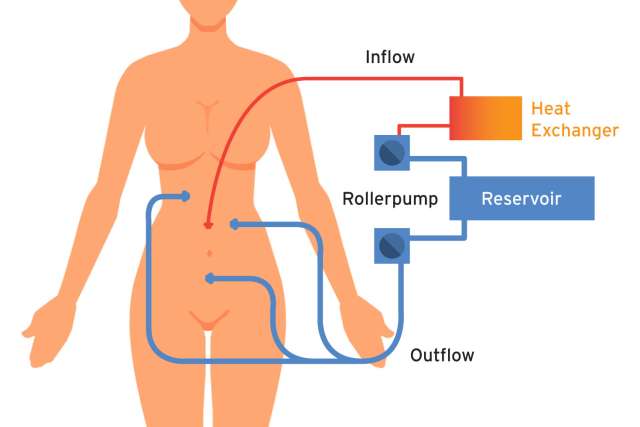A therapy utilizing a hybrid technique of surgical tumor removal and application of heated chemotherapy drugs to an affected area has become a well-established treatment for select groups of abdominal tumors.
Hyperthermic intraperitoneal chemoperfusion (HIPEC) is a two-step procedure that treats certain cancers in the abdomen, explains Jonathan C. King, MD, assistant professor of surgery. Using the procedures, cancerous tumors are surgically removed, followed by application of heated chemotherapy drugs directly inside the abdomen to eliminate remaining cancerous cells. The medication does not cross into the bloodstream, which minimizes potential side effects and allows for a higher, more effective dose of chemotherapy than would be possible if given intravenously.
“For these specific types of tumors, HIPEC is, in some cases, the only viable treatment option,” Dr. King says. He notes that it is effective for tumors that have spread only in the belly cavity and not to other organs such as the liver, lungs or through the bloodstream or lymphatic space. “The rationale is that by instilling the chemotherapy at the location of the tumor — and heating it — we achieve very high therapeutic doses of the drug without the whole-body side effects that can occur from intravenous (IV) chemotherapy,” he continues.
While HIPEC was introduced about four decades ago, it was not widely applied due to a lack of surgeons trained to perform it. UCLA is one of only a handful of centers in California to offer the treatment.
HIPEC most commonly is used with pat ients with mucinous tumors of the abdomen, including the appendix, and occasionally mesothelioma of the abdomen. “For these lower-grade tumors, it is potentially the mainstay of therapy,” Dr. King says. “Those are surgical diseases, so it’s a very clear indication. For this group, HIPEC improves survival and can even cure some of those lower-grade tumors that have only spread in the belly cavity.”
Other patients who might benefit from the procedure are those with colon and ovarian malignancies, but Dr. King notes that HIPEC is not appropriate for all such patients. “This is where it becomes an individualized treatment decision for when the disease spread is not maximal, but only within the belly,” he says. He adds that candidates’ tumors must be responsive to IV chemotherapy and the patient must be fit for surgery.
In such cases, HIPEC generally is an adjuvant to IV chemotherapies and is not usually a curative process. Rather, its aim is to extend survival by avoiding symptoms of spread within the abdomen. It can offer as much as a year of life above what traditional chemotherapy alone would offer, Dr. King says.
“Except for mucinous tumors where HIPEC is the standalone therapy, the best role for this service is in cooperation with other therapies,” Dr. King says. “We need to help physicians determine the optimal candidates and spread the word that we have this treatment available at UCLA.”




